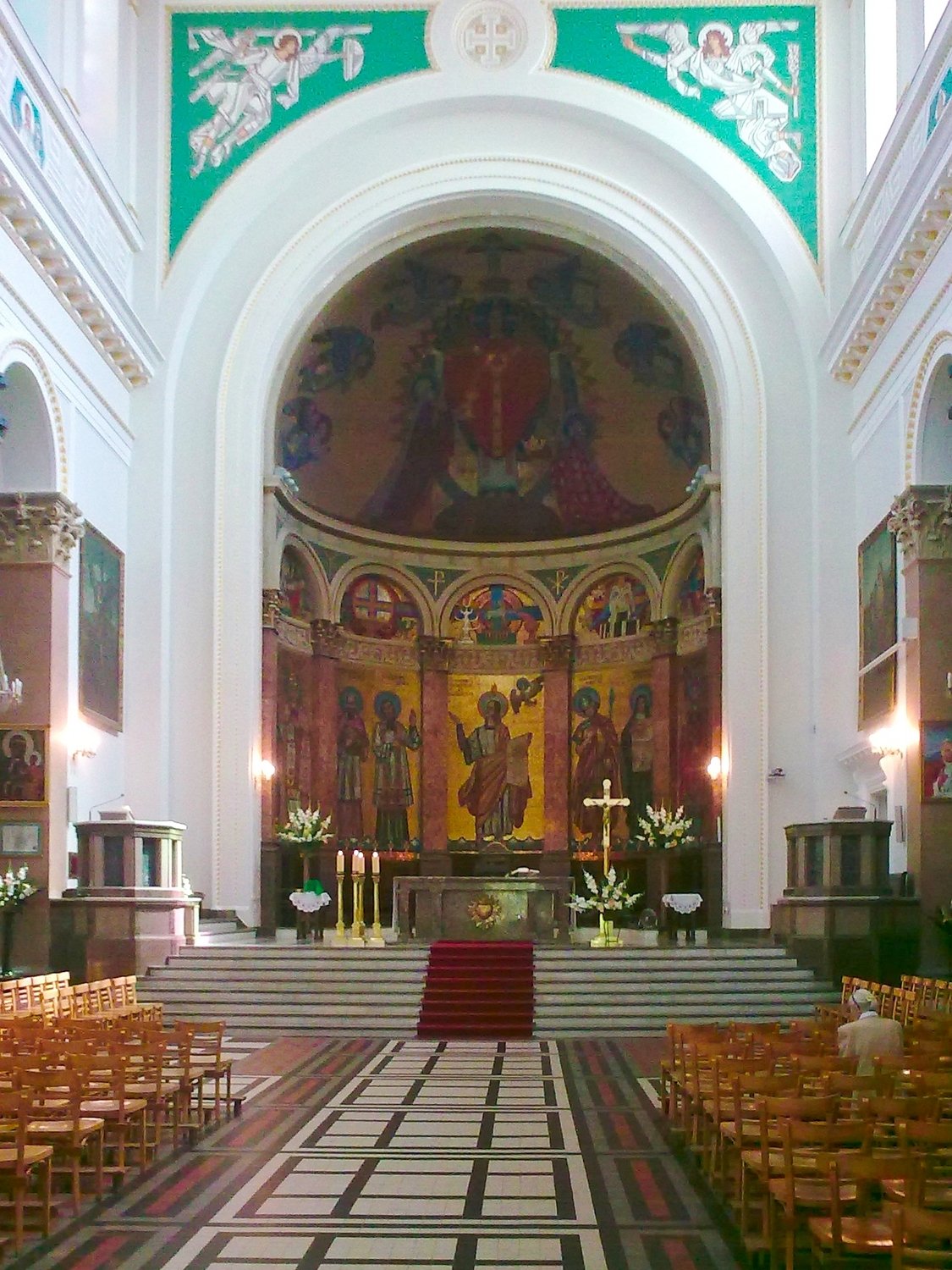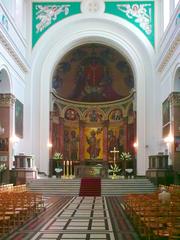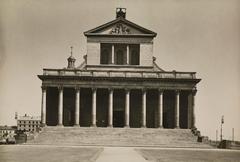
Church of the Sacred Heart of Jesus in Warsaw: Visiting Hours, Tickets, and Historical Significance
Date: 15/06/2025
Introduction
The Church of the Sacred Heart of Jesus (Kościół Najświętszego Serca Jezusowego) in Warsaw is one of the city’s most distinctive and significant religious landmarks. Located in the Praga-Północ district at ul. Kawęczyńska 53, it stands as a testament to Poland’s enduring Catholic tradition, architectural innovation, and vibrant community life. Renowned for its neo-Romanesque design, magnificent stained glass, and rich liturgical heritage, the church draws worshippers, history enthusiasts, and travelers alike. This guide provides detailed insights into the church’s origins, architectural and artistic features, cultural significance, practical visitor information, and tips for a memorable visit.
For further information, refer to trusted resources such as swiatynia3d.pl, Explore Warsaw, and the official parish website.
Table of Contents
- Historical Overview
- Architectural Features
- Artistic and Cultural Heritage
- Religious and Community Role
- Visitor Information
- Special Events and Liturgical Life
- Frequently Asked Questions (FAQ)
- Visual Resources
- Conclusion
- Sources
Historical Overview
The Church of the Sacred Heart of Jesus was constructed between 1907 and 1927, a period marked by dynamic growth in Warsaw’s Praga district. Its establishment was part of a broader movement to provide expanding suburbs with substantial places of worship that reflected both spiritual and national aspirations. The church’s dedication to the Sacred Heart of Jesus—a devotion celebrating Christ’s compassionate love—resonated powerfully in Poland, especially during times of national trial and renewal (Catholic Exchange).
Throughout its history, the church has played a pivotal role in the spiritual and cultural life of the city. It survived the devastation of two world wars and has undergone thoughtful restorations, including significant work following a fire in 2006. Over the decades, it has served not just as a place of worship, but as a center for community support, education, and cultural events.
Architectural Features
Exterior Design
The basilica’s imposing façade, inspired by the Roman Basilica of St. Paul Outside the Walls, features harmonious symmetry, classical proportions, and ornate stonework (tury.club). The entrance is framed by pilasters and attic-style decorations, with statues of Saint Peter and Saint Paul welcoming parishioners and visitors. A defining feature is the high lancet bell tower, completed at the close of the 20th century, which houses a historic 1712 bell—a rare artifact that audibly marks the passage of time in the district (tury.club).
Interior Layout
Inside, the basilica follows a classic basilica plan: a central nave flanked by aisles, separated by granite Corinthian columns (tury.club). The nave’s red sandstone floor and the chancel’s marble slabs create a sense of grandeur and permanence. The barrel-vaulted ceilings and massive dome above the transept draw the eye upward, enhancing the building’s spiritual atmosphere (en.wikipedia.org).
Decorative Elements
The church is adorned with Byzantine-inspired frescoes and stained glass windows depicting biblical scenes, saints, and national motifs. The altar area is richly decorated and framed by the apse, while chapels and sacristies provide space for private prayer and liturgical preparation. The transept features balconies supported by columns and adorned with statues of angels, emphasizing the sacredness of the space (evendo.com).
Artistic and Cultural Heritage
The basilica’s artistic program blends Neo-Romanesque, Byzantine, and Baroque influences. The church’s stained glass and frescoes serve not only as decorative masterpieces but also as visual catechisms, illustrating Christian teachings and Poland’s religious history (Explore Warsaw – Churches). Notable sculptures, paintings, and Baroque statuary were brought from various regions, demonstrating the interconnectedness of Poland’s sacred art.
The church’s designation as a Lesser Basilica by Pope Pius XI in 1923 further underscores its architectural and spiritual significance, with the Pope famously describing it as “the most beautiful church in Poland” (stacjapraga.pl).
Religious and Community Role
The Church of the Sacred Heart of Jesus is a thriving parish, offering daily Masses, sacraments, and spiritual formation. It is also a center for social outreach, housing a Social Assistance Center and various programs for the poor, elderly, and marginalized (tury.club). The devotion to the Sacred Heart is celebrated through regular First Friday services, special feast day processions, and Eucharistic Adoration, all of which are open to visitors and parishioners alike.
Beyond its religious functions, the church hosts concerts, art exhibitions, and educational programs, making it a lively hub for cultural engagement in the Praga-Północ district (Sacred Heart Church – Visitor Engagement).
Visitor Information
Visiting Hours
- Monday–Saturday: 7:00 AM – 7:00 PM
- Sunday: 8:00 AM – 8:00 PM
- Hours may extend during special events. Check the official parish website for current times.
Tickets and Tours
- Admission: Free; donations are appreciated for maintenance and restoration.
- Guided Tours: Available by prior arrangement, often in Polish. English tours can be arranged in advance. Group tours are recommended to book ahead via the parish office.
Accessibility
- Wheelchair Access: Ramps at the main entrance; accessible seating in the nave. Some upper areas may be inaccessible.
- Restrooms: Available during opening hours.
- Parking: Limited street parking; public transportation is strongly recommended (tram lines 7, 13, 24, and bus lines 118, 147, and 3, 6 to ‘Kawęczyńska’ stop).
Etiquette and Facilities
- Dress Code: Modest attire required—shoulders and knees covered, hats removed inside.
- Photography: Allowed outside Mass and liturgical celebrations; no flash. Professional equipment and filming require parish approval.
- Gift Shop: Sells religious articles, prayer cards, and souvenirs.
- Information Desk: Staff and volunteers provide assistance and historical background.
Nearby Attractions
- Soho Factory: Arts and cultural complex with galleries and cafes.
- Neon Museum: Dedicated to Polish neon history, located at Soho Factory.
- Skaryszewski Park: A spacious and scenic park.
- Other Churches: St. John’s Archcathedral and the Royal Castle Chapel are accessible for those interested in Warsaw’s ecclesiastical architecture (Nomadic Matt’s Warsaw Travel Guide).
Special Events and Liturgical Life
- Feast of the Sacred Heart (June): Major annual celebration featuring processions, Masses, and community gatherings.
- First Friday Devotions: Monthly Masses and Eucharistic Adoration.
- Concerts and Exhibitions: Classical music performances and art shows take place throughout the year, utilizing the basilica’s acoustics and artistic ambiance.
Frequently Asked Questions (FAQ)
Q: Is there an entrance fee or tickets required?
A: No; entrance is free. Donations are welcome.
Q: Can I attend Mass as a visitor?
A: Yes; all are welcome to attend regular liturgies.
Q: Are tours available in English?
A: Yes, with advance booking via the parish office.
Q: Is the church wheelchair accessible?
A: Main areas are accessible; some upper areas may have limited access.
Q: Are there nearby attractions to combine with a visit?
A: Yes; Soho Factory, the Neon Museum, and other historic churches are within walking distance.
Visual Resources
- Online Galleries: Visit the parish website for high-quality images of the church’s exterior, stained glass, and events.
- Virtual Tours: Where available, these provide a digital preview of the basilica.
- Maps: Use Google Maps (search for “Church of the Sacred Heart of Jesus Warsaw location map”) for directions and nearby points of interest.
Suggested alt text for images: “Facade of the Church of the Sacred Heart of Jesus in Warsaw,” “Stained glass windows inside Sacred Heart Basilica Warsaw,” “Interior nave with granite columns and domed ceiling.”
Conclusion
The Church of the Sacred Heart of Jesus in Warsaw exemplifies the city’s rich religious and cultural history. Its grand neo-Romanesque architecture, vibrant stained glass, and active parish life make it a must-visit for anyone interested in Warsaw’s ecclesiastical and artistic heritage. Whether you are seeking spiritual reflection, historical insight, or cultural enrichment, the church offers a welcoming and inspiring environment.
For the latest updates on visiting hours, events, and tours, consult the official parish website and trusted travel resources. Make the most of your Warsaw journey by including this basilica in your itinerary and exploring the dynamic Praga district.
Sources and Further Reading
- swiatynia3d.pl
- Sacred Heart Church – Visitor Engagement
- tury.club
- Official Parish Website
- Explore Warsaw – Churches
- Nomadic Matt Poland Travel Guide


































































































































































